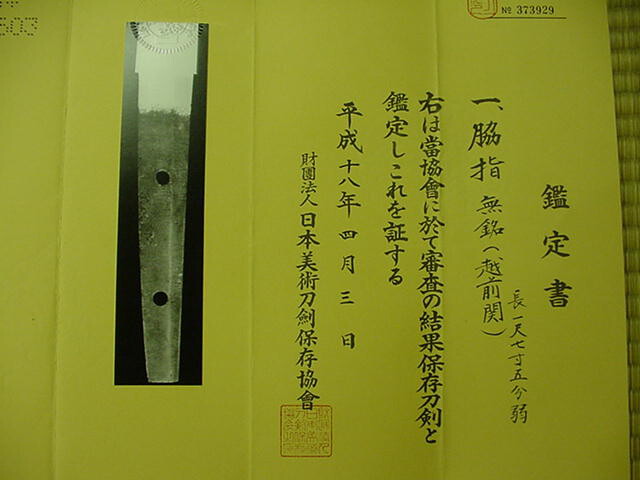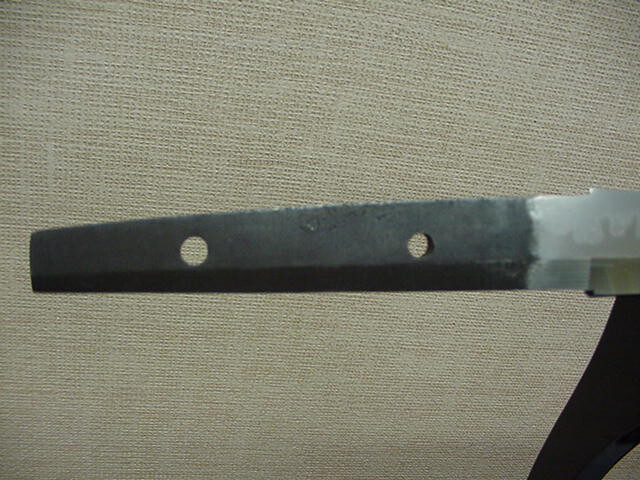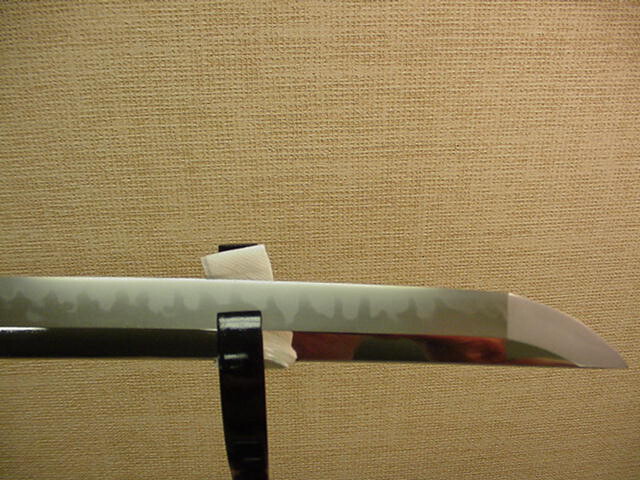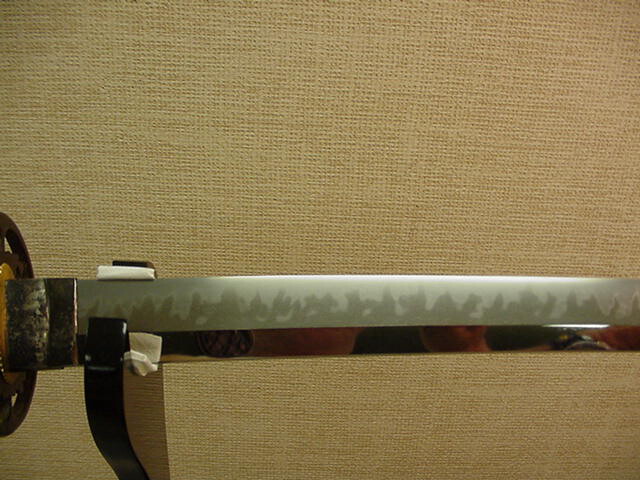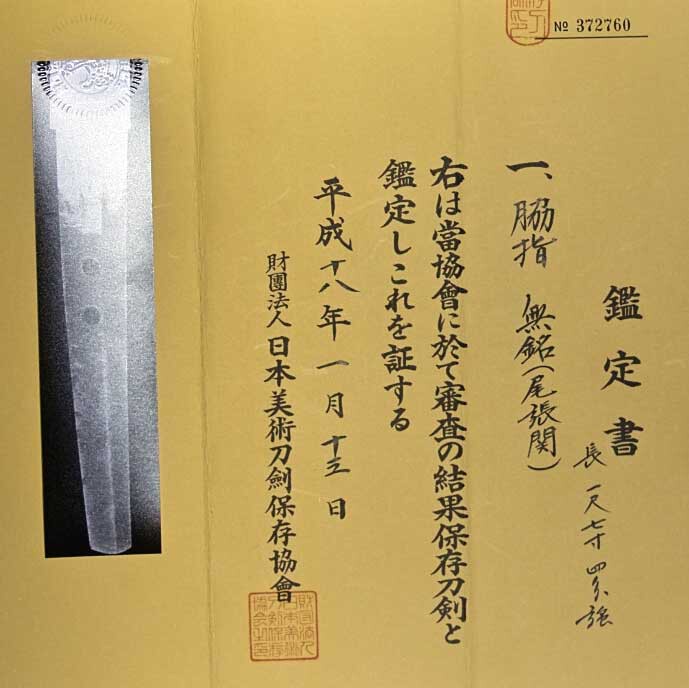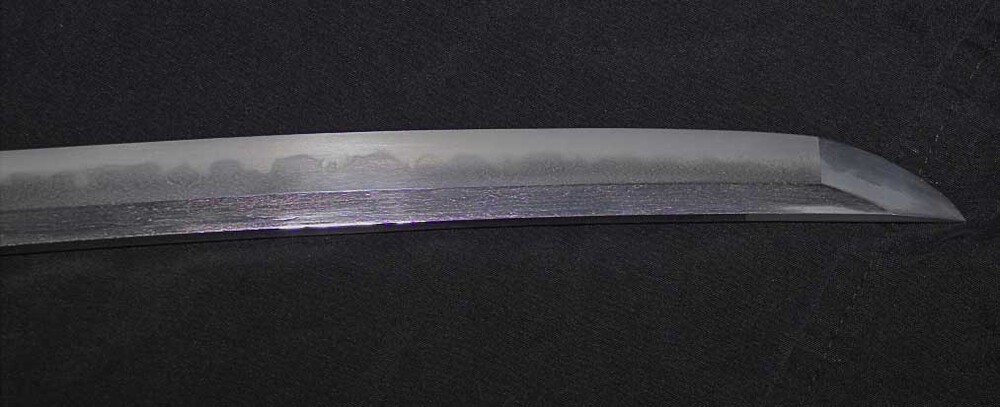-
Posts
7,353 -
Joined
-
Last visited
-
Days Won
91
Content Type
Profiles
Forums
Events
Store
Downloads
Gallery
Everything posted by Ken-Hawaii
-
I hadn't even noticed that part of this forum - thanks! I wasn't planning to buy anything from Thailand, having traveled there enough times to know how many fake items are offered, but it never dawned on me that the seller might be using photos from someone else.... Amazing how the criminal mind works. Actually, I'm really glad that it wasn't a fake blade! Think how hard it would be for any of us to buy a real Nihonto if it was...!
-
I was just browsing eBay looking for a kabuto, when I noticed that one of the sellers has what looks to be a very real katana for sale (item #140103694274). My Japanese isn't good enough to tell if the NHTBK papers are valid, but this could be quite a bargain if it turns out to be real. Is Thailand (or anyone else) putting out fakes that look this good? Comments?
-
Eric, I would make a beeline to http://www.satcho.com & check out Michael Harris' vast listing of sword books. He is very easy to deal with, & had ready answers to all my questions. I'm fairly certain that all of the books referenced above can be found on his Web-site. Happy hunting! :D
-

Can anyone give me some information about my katana
Ken-Hawaii replied to azizaedelam's topic in Nihonto
Probably about two weeks older than when you bought it, Mikael... -
I don't think there's any correlation between diamond-size & quality, Jeremy. Take a look at http://www.montanairon.com/tsukamaki.html & you can see that there are many types of tsuka-maki, with the tsuka wrapped in accordance with how the sword will be used. For even more detail, you might enjoy http://pages.prodigy.net/tlbuck/tsuka/tsuka.htm.
-
Mariuszk, a summary of Japanese sword laws are posted at http://www.nihontokanjipages.com/japanese_sword_laws.html. After reading these, do you really think that the Japanese government is about to toss them all out the window?[/i]
-
I hear what you're saying, Mike, but as I have worked almost 40 years as an engineer in metallurgy, I'm finding it hard to equate "hard" & "brittle" with "functional" & "reliable." I think I'm fairly familiar with how Nihonto were constructed, but the explanations I'm seeing for hitatsura on my wakizashi have me a bit perplexed. No argument that the ha/yakiba is harder than the mune, or that harder steel means better edge-retention & (generally) a sharper edge. But hard steel doesn't equate in my book with brittle steel, assuming the usual folding of the blade by a competent smith to minimize impurities. I read somewhere that metallurgical tests on Nihonto showed the average ha to have a hardness of up to 58 Rockwell, while the average mune was about 15-20 points softer. That's not unlike many modern-day knives - many of which I have broken in field use. I'm frankly still scratching my head why ashi lines help stop chipping of the yakiba; at most, I would expect a bit more flexibility of the blade, but 1000 years of swordsmiths obviously discovered this by trial & error. So does the hitatsura in my wakizashi help or hinder its usability? It's great for me to explore my blade a centimeter at a time, but if the brittleness of the entire structure might cause it to fail in battle, why would smiths build it that way? I can see that tobiyaki in the ji might be formed from nioi areas of concentration, but is hitatsura just the further spreading of nioi? I'm probably missing something simple here....
-
Anthony, I can't see any images of your Owari-Seki blade. Can you please retry?
-
Stephen, I've never asked Mike if he studied under Bob Benson. They definitely know each other, as we're all members of the Japanese Sword Society of Hawaii. I'll consider asking Mike when I see him this afternoon, but feel free to ask him yourself. FYI, Benson polished the Owari-Seki wakizashi, & I'd love to hear your comparisons on whether he or Mike did the best togi. I don't feel that I'm expert enough to make that decision/observation. Hmm. Looking at Walter Sorrell's Web-site, it does appear that Hitatsura (should that be capitalized? I didn't think it was a name.) is an interesting way to temper a blade. Why would a smith create a blade that is possibly too brittle to use in battle? Is Hitatsura more likely to be a mistake in clay application or a way to show off, rather than something actually planned? My wakizashi doesn't have hamon that crosses the shinogi, but then again I'm quite unlikely to use the blade in combat any time soon...:D. Onwards to provenance again, the only references I've found on-line so far mention Echizen-Seki as being roughly in 1660, & possibly near Mino again. I'm awaiting Barry's reference books, but if anyone has a bit more information, I can target my searches a bit better. Has anyone created a wiki that addresses Nihonto information? That would certainly be useful!
-
Good eyes, Martin! Yes, the blade was up on eBay for about a day because I didn't think it was in our budget. Linda, thank goodness, had other ideas about that, & told me to go visit Mike & buy it immediately. I'm headed over to see him again this afternoon as he found a kozuka for us that has a closely-related theme. I'm sure lucky to have a sword-swinging wife! Any of you have one, too? Stephen, his name is Mike Nii, with an appropriate e-mail address of hamon@hawaii.rr.com, & he lives out here in beautiful Hawaii. Are you looking for a togishi, or do you want to sell him a sword? Just curious. I have a question on exactly what "Hitatsura" means. As far as I know, it just means "tempered area" or something similar. Is there another meaning or definition?
-
I just added another NBTHK Hozon-papered wakizashi to our collection, this one attributed to Echizen Seki. The blade came from a friend of mine who is also the togishi, & wow, did he do a great job!! Let me know if you want his name & contact info. Mike has been a member of the Japanese Sword Society of Hawaii much longer than Linda & I have, & we obviously have a lot to learn from him. But back to the topic of Seki Nihonto, I haven't had a chance to start looking up the provenance, & would appreciate any comments. Curran, I now can see why you commented that people fall in love with this school. I can spend the next few years learning about just these two blades! I just noticed in the preview that the nakago is awfully blurred, so I'll have to reshoot that.
-
I'm more than happy to stick with my 2-4-5 iaito, Matthew, & my 2-5-5 shinken. If I want to hit someone any farther away than that, I'm sure I have some better long-range weapons stuck away somewhere.... Musashi Miyamoto was evidently rather taller than most of his contemporaries, & I've heard estimates up to six feet. So it's not too surprising that he would choose a longer katana than most others, too. I wasn't aware that his sword was resident in Shimada Museum, however. A quick Google search shows that Colin Hyakutake-Watkins evidently made a statement to that effect. Does anyone here know about that? As a European fencer for the past 55 years, I've spent quite a bit of time examining the differences in teaching methods & fencing techniques over the past 500-600 years as a function of how the swords were evolving. But if there's any correlation between Nihonto shape/size/etc. & training/technique, I haven't stumbled upon it. I guess a good starting question would be whether swordsmiths made new swords based on what their local daimyo requested, or if their sword-making just slowly evolved based on whichever new technology trickled in from other parts of Japan, Korea, & China.
-
Wow! I've never seen a blade as straight as that Tsuneyoshi, Curran! You're right that it "almost" looks like a point-weapon. I wonder what the swordsmith was thinking when he created it? With a relatively small cross-section, I'd be afraid that if another katana hit it, the blade would be cut through. The fact that it's still here centuries later is obvious proof that didn't happen, of course. However, the slight curve that we fencers add to our epees & foils is a completely different animal, as it allows the blade to bend upon contact. I've attended a match where the curve on a foil wasn't quite bent enough, & the opponent was skewered when the blade broke - not a pretty sight, believe me :x . Fencing jackets are definitely not bogu or yoroi. Different sword, different intent...or there would a lot fewer fencers! Kinda' like why kendo was invented: to keep samurai alive while they learned the sword techniques. On comparing blade shapes/sizes/thicknesses evolving with the number & types of ryu/ryuha, has anyone done a comparison on that? I read through Meik's article (& a lot more on that Web-site, as I hadn't visited there in too long), but this question isn't addressed directly.
-
Actually, John, my favorite weapon is the epee, followed by the foil. There's a sneaky attack that I use in epee on my opponent's big toe. If I connect, he's out of the bout. And even if I miss, he stays a long way away from me after that! They don't make steel-toed fencing shoes, thank goodness! On the lozenge-shaped blade, are you talking about a katana or a sword?? I've seen several medieval swords that shape, but never a katana.
-
A well-written article, John. I'm going to point Sensei at your Web-site when I see him next weekend. Perhaps we should collaborate on adding chapters or sections on the various modern weapons (both edged & pointed). Browsing, I see a great shot of an early 18th-century steel-hilted small sword. This was the near-descendant of the rapier, & looks to be at least partially suitable for edge work. I had a sword very similar to that, but it disappeared in our move to Hawaii 15 years ago. My sword was actually extremely well balanced, with the balance point about two inches from forte. Main gauche is not really a problem if one has been fencing for any time, as wrist & forearm bulk up rapidly. As far as how the small sword would fare against the katana, John, that's been a heavily discussed topic at the salle where I teach masters classes. This being Hawaii, there are a lot of students who also collect katana, albeit usually fake wall-hangers, but we've had many hours of discussions on the basic efficiencies of each weapon. There are a number of factors that we've concluded: (1) a point weapon is generally more effective than a blade-only weapon, mostly due to its greater reach; (2) however, a blade weapon made of superior steel could likely cut through the thinner point weapon; (3) but katana, at least as used in iaido/kenjutsu, were generally taught primarily as offensive, rather than defensive, weapons; (4) while point weapons generally have eight zones of defense (at least in modern fencing); (5) leading to the conclusion that whoever started the attack would probably win, weapon notwithstanding. I've been fencing for over 50 years, & hold dan in MJER iaido, John, so I not only have experience in both arenas, but I also am constantly looking for ways to illustrate weapons teachnology. If I pitted my shinken, for example, against my modern epee, I'm fairly certain that the shinken would win, as it could easily cut through the rather thin metal blade. But using a contemporary katana up against the small sword on your Web-site would likely be a different story. That sword's steel is significantly thicker, & with a near-triangular cross-section would have been much harder to cut. A fun discussion.
-
I would love to see the saber that you used to use, Curran!! I will admit that I haven't seen the number of Nihonto that you have, but I certainly have never seen one that reminds me in any way of a rapier, saber, or epee. It's interesting that, from Rich's comments, modern European fencing may be several hundred years older than formalized Kenjutsu, having started in the 14th century. Browse over to http://library.thinkquest.org/15340/historyessay.html?tqskip1=1 for a summary of how & when fencing got started. Does anyone have definitive data on when formalized Kenjutsu actually started? It would be fascinating to compare that evolution against the look & feel of Nihonto.
-
A well-thought-out answer, Curran. Thanks! My preference (favorites, actually) in Nihonto so far are my two Bizen, mostly because there's so much hamon activity to study. But my new Owari-Seki wakizashi is well up in the running, too. I've been going for "pretty" & "interesting" blades more than anything else, probably because I don't yet know enough to concentrate on a specific smith or school :? . What is it about Edo schools that will appeal to me as a fencer, Curran? I've been fencing for well over 50 years, but other than a few rapiers, don't collect fencing swords. I'm quite interested in that observation.
-
A well-thought-out answer, Curran. Thanks! My preference (favorites, actually) in Nihonto so far are my two Bizen, mostly because there's so much hamon activity to study. But my new Owari-Seki wakizashi is well up in the running, too. I've been going for "pretty" & "interesting" blades more than anything else, probably because I don't yet know enough to concentrate on a specific smith or school :? . What is it about Edo schools that will appeal to me as a fencer, Curran? I've been fencing for well over 50 years, but other than a few rapiers, don't collect fencing swords. I'm quite interested in that observation.
-
Curran, that brings up a good question that I've wondered about for awhile. Should we collectors concentrate on a given period or swordsmith school, or should we instead try to accumulate gorgeous blades that make for interesting study? My collector friends have gone both ways. I have one friend who must have 25 Bizen Nihonto, which I enjoy examining. But another friend has nearly 100 blades, no two of which are from the same school, & I enjoy those at least as much. Both of them are lucky that their budgets are almost unlimited. Linda & I, on the other hand, will likely stop at a dozen or so in our collection. Which way is the best??
-
I'm not real surprised that my wakizashi was appraised as a not-very-specific school, John. It's certainly not the first time I've seen that happen. Our local sword society has three shinsas as members, however, & they have agreed to take a close look at my blade to see what they can determine. When I can get that level of help, I'm not worried about provenance...yet. I also videotape the examination & discussion, which probably teaches me more about Nihonto than any amount of reading I can do . Besides, my wakizashi is a lot of fun just to look at & admire, & I can also learn a lot more with a blade that isn't precisely appraised (not that I could afford one that is perfectly identified).
-
I am truly grateful for all of the useful responses to my post. It's great to have such a resource. My wife & I are heavily involved in martial arts (Linda studies kendo, iaido, & jodo, while I study iaido & jodo, & teach judo & European fencing), & were introduced to Nihonto only a few years ago. But we're making up for that in a hurry! I can see that this forum will be an excellent place to buy a few blades. I got my digital camera working, & have included a few photos of my wakizashi & Hozon origami. Please provide any comments, & continue to point me in the direction of Owari-Seki info.
-
Aloha: At last weekend's Honolulu gun & sword show, I was lucky enough to find a beautiful wakizashi with NBTHK Hozon origami that I could afford. The paper reads Owari Seki, but that's about all the information I've been able to locate. With all of the searches available for the Web, I'm rather surprised that there is so little information on that particular school of swordsmiths. At the end of the Muromachi period, a number of swordsmiths migrated from Mino province to Owari, where they happily made great swords for many years. Does anyone have a bit more information on smiths from the Owari-Seki school? My wakizashi is mumei, & I'm very interested in tracking down its maker & any other information. As soon as I get my digital camera back from the shop, I'll be happy to post a few photos. Mahalo! (Thanks!)


